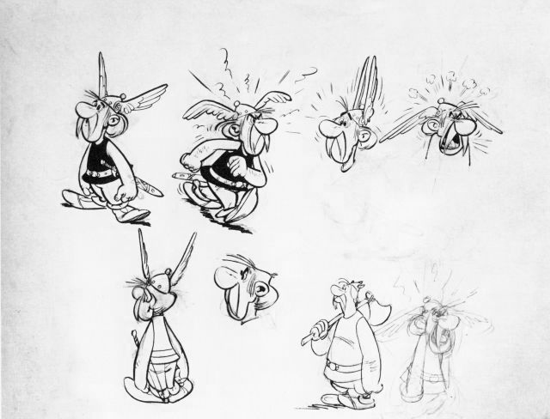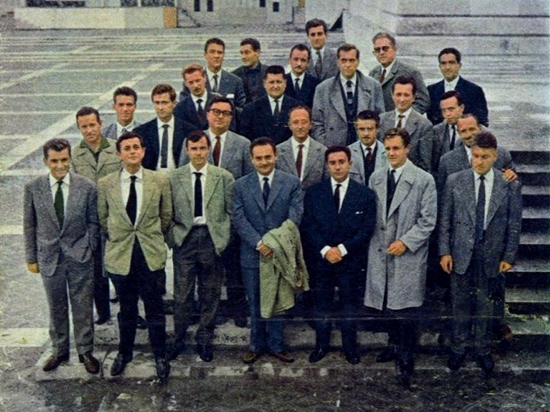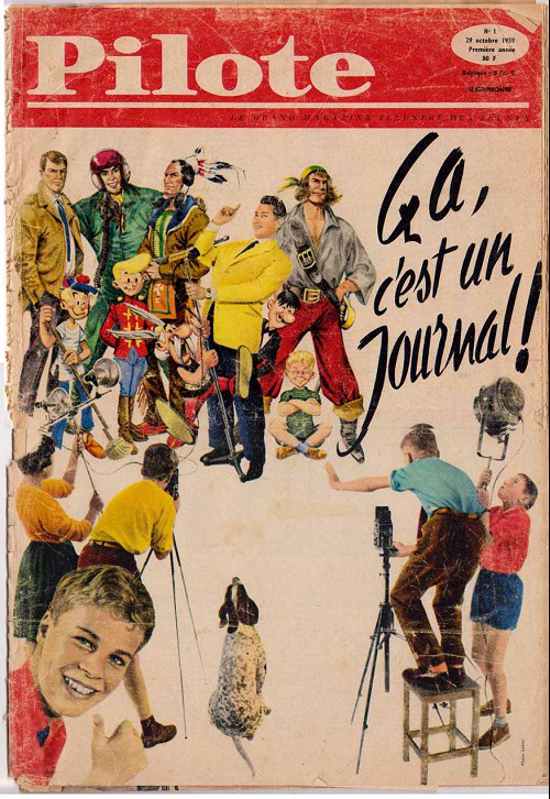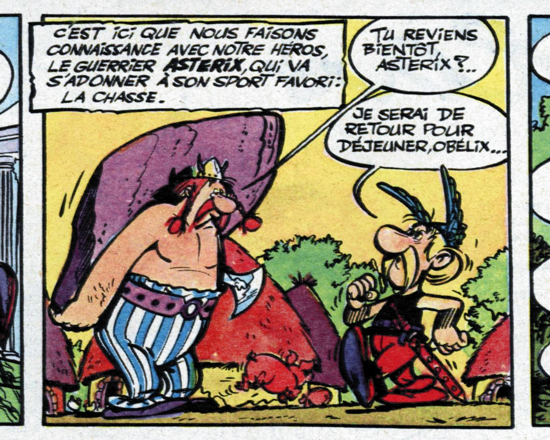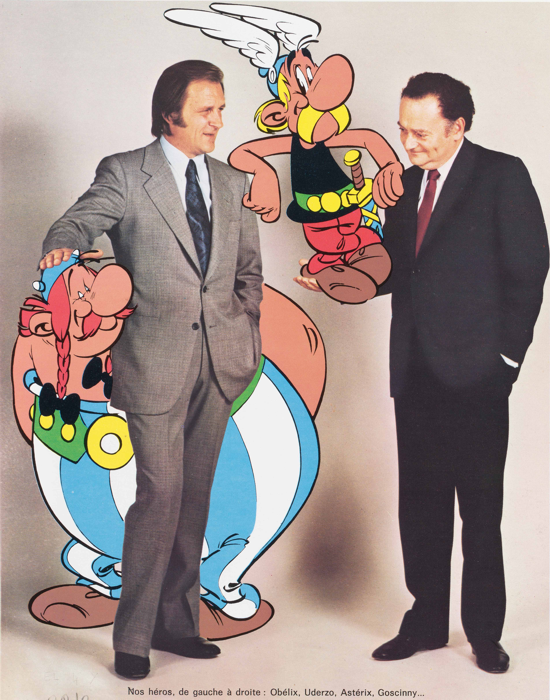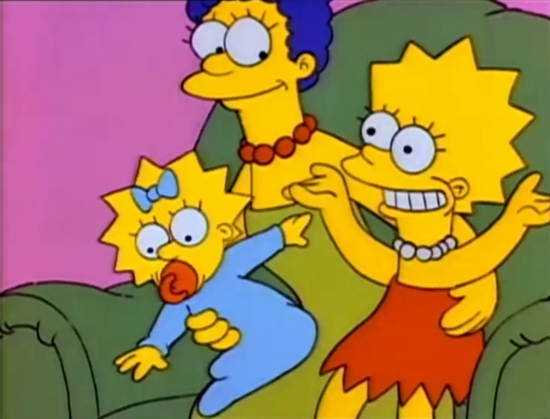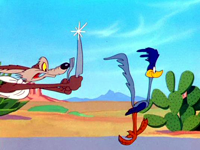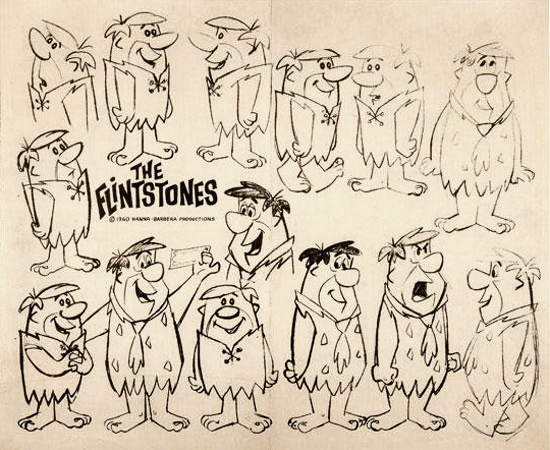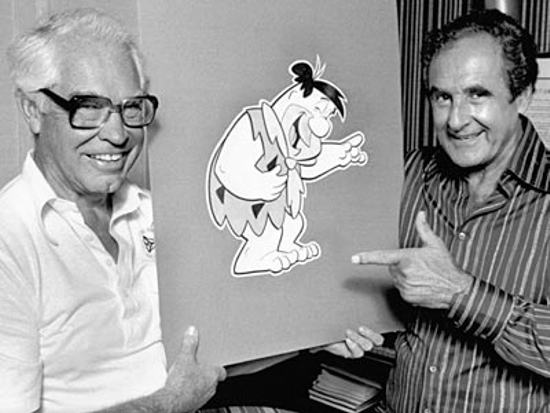 |
| Tom and Jerry, first opening with official series title 1941 |
Series title: "Tom and Jerry"
Category: Cartoon
Genres: Short, Comedy, Humor, Slapstick
Creators/Directors:
--- William Hanna
--- Joseph Barbera
--- William Hanna
--- Joseph Barbera
Country of origin: USA
Released: February 10, 1940 - USA
No. of shorts (original series): 114 shorts, last released on August 1, 1958
Producers:
--- Rudolf Ising (1940)
--- Fred Quimby (1940–55)
--- William Hanna (1955–58)
--- Joseph Barbera (1955–58)
--- Rudolf Ising (1940)
--- Fred Quimby (1940–55)
--- William Hanna (1955–58)
--- Joseph Barbera (1955–58)
Production company: Metro-Goldwyn-Mayer Cartoon Studio
Distributor: Metro-Goldwyn-Mayer
Running time: 6-10 min.
Color: Technicolor
Original language: English
Background: The series revolve around a grey and white domestic cat, Tom, and a little brown mouse, Jerry, who spite each other: usually, Tom attempts to catch Jerry, but rarely succeeds, causing only trouble; so the shorts generally end showing the mouse triumphant.
Main characters (in order of appearance):
--- Jerry: named Pee-Wee in the first official announcement (see below), named Jinx in the first short (but not referred to in name on-screen), named Jerry since second short; first appearance in the first short "Puss Gets the Boot", February 10, 1940. Small brown house mouse, one of the two main protagonists of the series along with Tom.
--- Tom: named Jasper in the first official announcement (see below), named Jasper also in the first short, named Tom (full name Thomas) since second short; first appearance in the first short "Puss Gets the Boot", February 10, 1940. Grey and white domestic shorthair Tuxedo cat, one of the two main protagonists of the series along with Jerry.
--- Mammy Two Shoes: first appearance in the first short "Puss Gets the Boot", February 10, 1940. African-American housemaid, Mammy Two Shoes catches Tom acting against her orders. As a minor figure, her face is almost never shown.
--- Spike: occasionally named Killer/Butch/Bulldog in a few shorts; first appearance in the fifth short "Dog Trouble", April 18, 1942. Grey American bulldog, Spike has little affection for Tom; despite so, his relationships with Tom and Jerry varies from time to time.
--- Butch: first appearance in the 12th short "Baby Puss", December 25, 1943. His very first appearance, as Butch's only solo cartoon along Toodles Galore, took place in the MGM short "The Alley Cat" (July 5, 1941). Black alley cat, leader of Tom's friends alley cat bullies who often help him catch Jerry.
--- Toodles Galore: first appearance in the 23th short "Springtime for Thomas", March 30, 1946. Her very first appearance, as Toodles Galore's only solo cartoon along Butch, took place in the MGM short "The Alley Cat" (July 5, 1941). Attractive white female cat, Toodles is Tom's most favored love interest.
--- Tyke: first appearance in the 44th short "Love That Pup", October 1, 1949. In this short Spike was given a puppy son, Tyke precisely, who became a popular supporting character in the series. Spike is a loving father to his son Tyke.
--- Jerry: named Pee-Wee in the first official announcement (see below), named Jinx in the first short (but not referred to in name on-screen), named Jerry since second short; first appearance in the first short "Puss Gets the Boot", February 10, 1940. Small brown house mouse, one of the two main protagonists of the series along with Tom.
--- Tom: named Jasper in the first official announcement (see below), named Jasper also in the first short, named Tom (full name Thomas) since second short; first appearance in the first short "Puss Gets the Boot", February 10, 1940. Grey and white domestic shorthair Tuxedo cat, one of the two main protagonists of the series along with Jerry.
--- Mammy Two Shoes: first appearance in the first short "Puss Gets the Boot", February 10, 1940. African-American housemaid, Mammy Two Shoes catches Tom acting against her orders. As a minor figure, her face is almost never shown.
--- Spike: occasionally named Killer/Butch/Bulldog in a few shorts; first appearance in the fifth short "Dog Trouble", April 18, 1942. Grey American bulldog, Spike has little affection for Tom; despite so, his relationships with Tom and Jerry varies from time to time.
--- Butch: first appearance in the 12th short "Baby Puss", December 25, 1943. His very first appearance, as Butch's only solo cartoon along Toodles Galore, took place in the MGM short "The Alley Cat" (July 5, 1941). Black alley cat, leader of Tom's friends alley cat bullies who often help him catch Jerry.
--- Toodles Galore: first appearance in the 23th short "Springtime for Thomas", March 30, 1946. Her very first appearance, as Toodles Galore's only solo cartoon along Butch, took place in the MGM short "The Alley Cat" (July 5, 1941). Attractive white female cat, Toodles is Tom's most favored love interest.
--- Tyke: first appearance in the 44th short "Love That Pup", October 1, 1949. In this short Spike was given a puppy son, Tyke precisely, who became a popular supporting character in the series. Spike is a loving father to his son Tyke.
Features: The birth of Tom and Jerry dates back in 1939, at Metro-Goldwyn-Mayer cartoon studio, when animator and storyman Joseph Barbera teamed up with animator and director William Hanna to develop some popular recurring characters like the other studios had. Their idea about a cat and a mouse always in conflict with each other was not entirely appreciated by producer Fred Quimby, despite this he let they go ahead and produce one cartoon short. This first short, titled "Puss Gets the Boot", was released to theaters on February 10, 1940, achieving great critical acclaim and earning an Academy Award nomination for Best Short Subject: Cartoons - the first nomination of a total of 13 in the series of 114 shorts directed by Hanna and Barbera until 1958, seven of which won the Oscar.
In 1957 MGM cartoon studio closed, and Hanna and Barbera founded an own production company to produce such popular animated television series including The Flintstones, Yogi Bear, and Scooby-Doo; however, over the years, Tom and Jerry have been relaunched several times by others directors through theatrical shorts, television series, spin-offs, movies and so, until the present day.
In 1957 MGM cartoon studio closed, and Hanna and Barbera founded an own production company to produce such popular animated television series including The Flintstones, Yogi Bear, and Scooby-Doo; however, over the years, Tom and Jerry have been relaunched several times by others directors through theatrical shorts, television series, spin-offs, movies and so, until the present day.
Interesting facts: In the original series (1940-1958) Tom and Jerry rarely spoke, and creator William Hanna himself provided most of their vocal effects, including Tom's trademark scream, and Jerry's nervous gulp. Hanna and Barbera made minor adjustments to Tom and Jerry's appearance over the years, so they would "age gracefully".
Property: Metro-Goldwyn-Mayer
TOM AND JERRY - FIRST SHORT
First short title: "Puss Gets the Boot"
Released: February 10, 1940 - USA
Directors:
--- William Hanna
--- Joseph Barbera
--- Rudolf Ising
--- William Hanna
--- Joseph Barbera
--- Rudolf Ising
Plot: See the official announcement below
Music: Scott Bradley
Animation: Don Williams, Michael Lah, Jack Zander, Peter Burness, Rudy Zamora, Ray Abrams, Tony Pabian, Carl Urbano, Robert Allen, George Gordon, Lovell Norman, Al Grandmain.
Running time: 9 min. 8 sec.
 |
| Tom and Jerry, opening and first scenes from the first short: "Puss Gets the Boot" (February 10, 1940). Released to theaters, the short achieved great critical acclaim and earned an Academy Award nomination for Best Short Subject: Cartoons in 1941. |
 |
| Tom e Jerry, official announcement for the first short "Puss Gets the Boot" released on February 10, 1940 (Metro-Goldwyn-Mayer Shorts Story magazine, January-February 1940). «PUSS GETS THE BOOT... Since Eve evolved from Adam's rib, cats have waged constant war against mice. Now comes a one-mouse revolution brought on by a cat, that ends in victory for the mouse. This story, as told in Rudolf Ising's latest M-G-M Cartoon, "Puss Gets the Boot," relates how this one small mouse, taking advantage of one large cat's shortcoming, subdues the large warrior in a battle of wits and with the aid, of course, of circumstances. Ising's cat feels particulary wicked, this day. Before putting an end to the mouse of his choice, he decides to toy with it. As the mouse pokes his headout of his hole, friend cat grabs him with his tail, flips him in the air, and lets him fall to the floor senseless. The cat then dips his paw into some ink and draws a false hole in the wall for the mouse. As soon as he awakens, the mouse makes a dash for his hole, runs into the solid wall and is knocked unconscious again. This time, when he awakens, he is angry. With great courage he strolls up to the cat and punches him right in the eye. Furious, the cat runs after the mouse, and dashes right into a pillar that supports a beautiful vase. The vase falls to the floor, crashes into a thousand pieces, and the cat, Jasper, by name, is in for it. Immediately the housekeeper chases after Jasper with a broom, beats him, and warns him that if anything else is broken in the house, he will be thrown into the street forever. Now, the mouse, named Pee-Wee, knows how to handle Jasper. If Jasper tries to hurt him again, he'll break something and blame it on the cat. The next time Jasper chases Pee-Wee, the mouse runs to the edge of a table, grabs one of a set of cocktail glasses, and defiantly shouts that he will drop the glass if the cat comes any closer. With each of Jasper's lunges, Pee-Wee threatens to drop the glass. Finally, just to be ornery, Pee-Wee does drop the glass which Jasper catches, before it breaks, by the skin of his theet. Another glass and still another come hurtling down with Jasper catching each one before it hits the floor. Now Jasper gets wise and places soft cushions all over so that even if Pee-Wee does drop the glasses, they won't break. Jasper moves toward Pee-Wee, who threatens to drop another glass. Jasper laughs, the mouse drops the glass and it falls on the pillows and doesn't break. Immediately, Pee-Wee is in Jasper's tail, being tossed up and down like a ball of wool. But Jasper flips Pee-Wee a bit too high. The mouse catches on the ledge of a mantel on which there are many valuable plates. Immediately he starts throwing them to the floor. The cat dashes around madly, catching each dish until his arms are full. Calmly, Pee-Wee comes down from the mantel, and kicks Jasper right into next week. Up in the air goes every dish, and down they come. The housekeeper catches the cat and banishes him from the house forever. Calmly, and with great confidence, Pee-Wee strolls back to his hole, sighing. "Home, Sweet Home."» |
 |
 |
 |
| Tom and Jerry, original hand drawn concept designs (August 8, 1939) for the first short "Puss Gets the Boot" (February 10, 1940) |
 |
| Tom and Jerry, characters names appeared for the first time as the official opening title of the series in the second short: "The Midnight Snack" (July 19, 1941) |
 |
| Tom e Jerry, official announcement for the second short "The Midnight Snack" released on July 19, 1941 (Metro-Goldwyn-Mayer Shorts Story magazine, July-August 1941). «MIDNIGHT SNACK - The same cat and mouse who were so well received in their first Metro-Goldwyn-Mayer cartoon, "Puss Gets the Boot," are back again, by public demand, in another co-starring vehicle titled "Midnight Snack." Supervised by William Hanna and Joe Barbera, the Technicolor one-reeler opens on Jerry, a little mouse, loaded down with a big slice of cheese, struggling away from the ice-box. He looks about cautiously as he staggers forward, making sure that he isn't being followed by Jasper, the cat. (...)» |
 |
| Mammy Two Shoes debut ("Puss Gets the Boot", February 10, 1940) and first of her rare appearances in full body ("Saturday Evening Puss", January 14, 1950) |
 |
| Spike and Tyke in their first appearances (left: Tom and Spike in "Dog Trouble", April 18, 1942 / right: Spike and Tyke in "Love That Pup", October 1, 1949) |
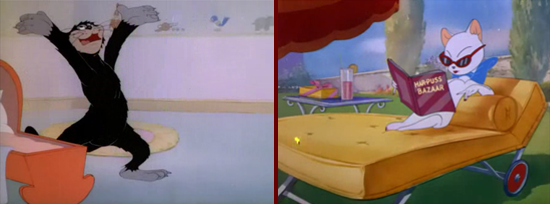 |
| Butch and Toodles Galore in their first appearances (left: Butch in "Baby Puss", December 25, 1943 / right: Toddles Galore in "Springtime for Thomas", March 30, 1946). Butch and Toddles Galore, before being integrated as recurring characters into the Tom and Jerry series, were introduced in the MGM only solo short "The Alley Cat" (July 5, 1941) by Hugh Harman. |
 |
| Tom and Jerry, theatrical poster for "The Yankee Doodle Mouse" (June 26, 1943) - first of 7 Oscars winning shorts in the series for Best Short Subject: Cartoons |
 |
| Tom and Jerry, first cast in a live-action/animated movie: "Anchors Aweigh" (1945, musical comedy by George Sidney starring Frank Sinatra, Kathryn Grayson, and Gene Kelly). The movie is remembered for the sequence in which Gene Kelly dances along with Jerry. |
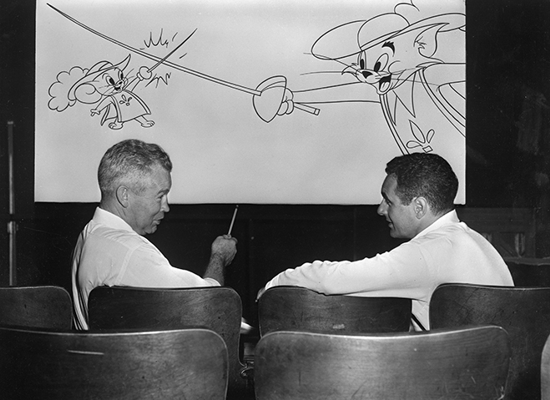 |
| The creators of Tom and Jerry: William Denby "Bill" Hanna (Melrose, July 14, 1910 - North Hollywood, March 22, 2001), American animator, director, producer, voice actor, and cartoon artist; Joseph Roland "Joe" Barbera (New York City, March 24, 1911 – Los Angeles, December 18, 2006), Italian-American animator, director, producer, storyboard artist, and cartoon artist. |
 |
| William Hanna and Joseph Barbera pose alongside all the Oscars won by their Tom and Jerry shorts for "Best Short Subject: Cartoons" under their direction (1940 to 1958: 7 Oscars and 6 nominations) |
You might also like, by the same authors Hanna and Barbera:
--- The Flintstones


